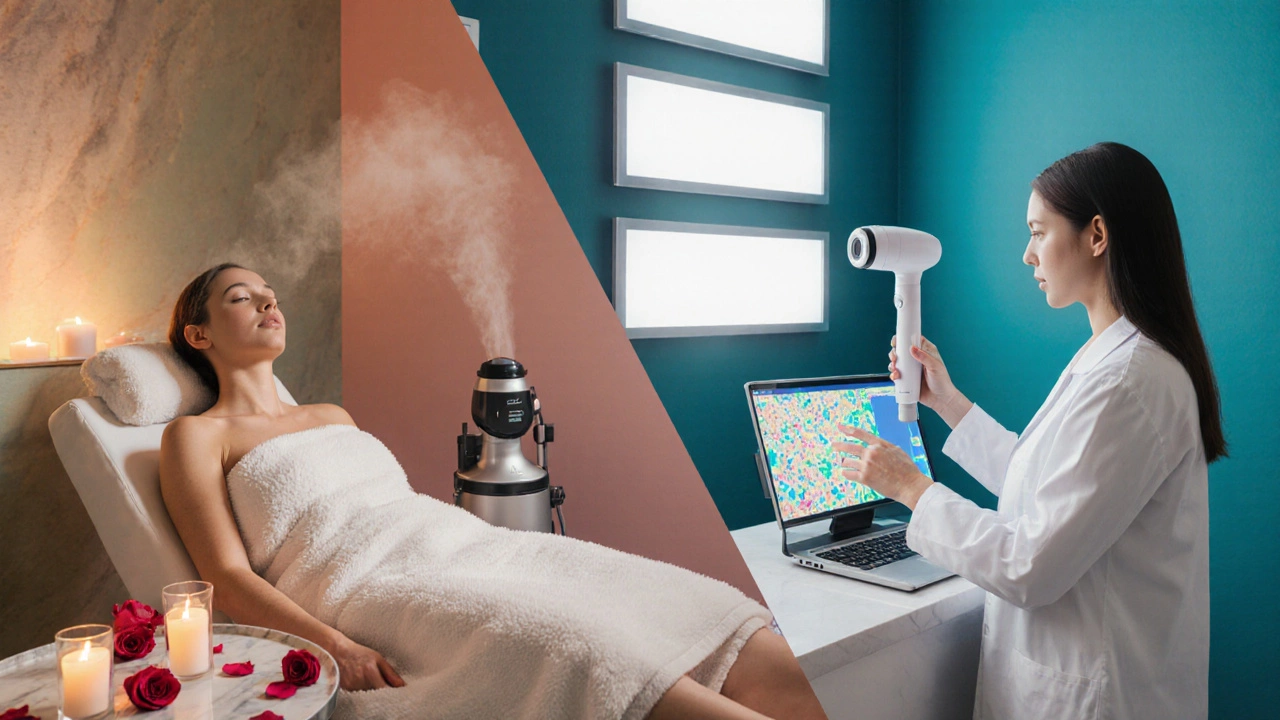Ever walked into a spa and wondered if the pricey "medical grade facial" is worth the extra bucks compared to a regular facial? You’re not alone. The truth is, the two treatments serve different goals, use distinct tools, and cater to different skin needs. Below we break down what each involves, why the ingredients and tech matter, and how to decide which one fits your routine.
What Is a Medical Grade Facial is a professional skincare session that uses clinically‑tested ingredients, advanced diagnostic tools, and procedures typically overseen by a medical professional?
A medical grade facial is more than a fancy mask. It’s a skin‑care protocol performed in a medical‑aesthetic setting-often a dermatology clinic, a med‑spa, or a licensed esthetician’s office with physician oversight. The treatment blends high‑potency actives (think 20% vitamin C serums, prescription‑strength retinoids, or hyaluronic acid at concentrations above 2%) with technology such as laser‑light, radiofrequency, or micro‑needling. Because the ingredients are regulated and the devices are FDA‑cleared, the results can target deeper concerns like severe acne, hyperpigmentation, or collagen loss.
What Is a Regular Facial is a spa‑based skin‑care service that focuses on cleansing, exfoliation, massage, and basic moisturising using over‑the‑counter products?
A regular facial, often called a classic or luxury facial, is designed for relaxation and surface‑level skin health. It’s typically delivered by a licensed esthetician in a salon or spa. The steps include cleansing, gentle exfoliation (often with a mild scrub or enzyme mask), steam, a facial massage, a mask suited to your skin type, and a light moisturizer. The actives used are generally at lower concentrations and the equipment is limited to tools like facial steamers or basic LED devices.
Core Differences at a Glance
| Aspect | Medical Grade Facial | Regular Facial |
|---|---|---|
| Provider | Dermatologist, physician‑supervised esthetician | Licensed esthetician or spa therapist |
| Active Ingredients | Prescription‑strength retinoids, 20%+ vitamin C, high‑dose hyaluronic acid, peptide complexes | Over‑the‑counter serums, botanical extracts, light moisturizers |
| Technology Used | Laser/light therapy, radiofrequency, micro‑needling, Skin Analysis Technology is a digital device that assesses hydration, oil levels, and pigmentation to tailor treatments, LED therapy | Steam, basic LED mask, manual massage tools |
| Depth of Treatment | Targets dermal layers (collagen, elastin), can stimulate cellular turnover | Focuses on epidermal layer (surface cleansing & hydration) |
| Typical Session Length | 45‑90 minutes (depends on procedure mix) | 60‑75 minutes |
| Recovery Time | Possible redness, mild peeling (up to 48hrs) | None, immediate return to daily activities |
| Cost (US) | $150‑$350 per session | $70‑$120 per session |
Who Should Choose Which?
If you’re battling stubborn acne, deep wrinkles, or melasma that hasn’t responded to OTC products, a medical grade facial could be a game‑changer. The higher potency ingredients and targeted devices are designed to reach the deeper layers where these issues originate.
On the flip side, if your main goal is to unwind, keep skin supple, and maintain a healthy glow, a regular facial delivers that soothing experience without the downtime.
Here’s a quick rule‑of‑thumb:
- Medical grade facial: Severe skin conditions, post‑procedural skin repair, anti‑aging focus, desire for clinically measurable results.
- Regular facial: General maintenance, stress relief, mild dryness or congestion, occasional pampering.
Typical Session Breakdown
Both treatments follow a structured flow, but the steps diverge after the initial cleanse.
- Consultation & Skin Analysis: A Dermatologist is a medical doctor specializing in skin health who can diagnose conditions and prescribe treatments (or a licensed physician‑assistant) evaluates your skin using a handheld scanner.
- Deep Cleansing: Medical grade facials use oil‑free, non‑comedogenic cleansers that may contain salicylic acid; regular facials stick to gentle foaming cleansers.
- Exfoliation: For the medical version, a Chemical Peel is a controlled application of acids (AHA/BHA) that dissolves dead skin cells and stimulates renewal of 10‑20% strength may be applied. Regular facials often use a light enzyme mask.
- Targeted Treatment: Medical facial introduces high‑dose serums (e.g., 20% vitamin C) followed by a device‑assisted step like LED Light Therapy is a non‑invasive light source that reduces inflammation and boosts collagen or micro‑needling. Regular facial skips this and moves straight to a soothing mask.
- Massage & Lymphatic Drainage: Both may include a facial massage, but the medical version often incorporates lymphatic drainage to reduce swelling.
- Finishing Serum & Moisturiser: High‑potency moisturisers with peptides are typical for medical facials; regular facials use lighter, fragrance‑based lotions.
Benefits vs Risks
Medical Grade Facial Benefits
- Clinically proven reduction in fine lines (up to 30% in 8 weeks).
- Significant improvement in acne scar texture.
- Long‑lasting collagen stimulation.
Potential Risks
- Temporary redness, peeling, or mild swelling.
- Higher cost and need for post‑treatment care (sunscreen, gentle cleansers).
- Contra‑indications for pregnant individuals or those with certain skin disorders.
Regular Facial Benefits
- Instant relaxation and stress relief.
- Improved skin hydration and surface glow.
- Minimal to no downtime.
Potential Drawbacks
- Limited impact on deep wrinkles or severe acne.
- Results often temporary, requiring frequent sessions.
Cost and Availability
Medical grade facials tend to be priced higher because they involve licensed medical staff, patented ingredients, and expensive equipment. Expect to pay between $150‑$350 per session, with packages offering a slight discount for multiple visits.
Regular facials are more widely available in day spas, hotels, and boutique salons. Prices range from $70‑$120, and many places offer membership plans that bring the cost down further.
Quick Takeaways
- Medical grade facials use clinical‑strength actives and FDA‑cleared devices; regular facials rely on gentle, over‑the‑counter products.
- Choose a medical grade option for targeted anti‑aging, severe acne, or pigment issues.
- Opt for a regular facial when you want relaxation, surface moisturisation, and no recovery time.
- Costs reflect the expertise and technology-budget accordingly.
- Both treatments can complement each other; a regular facial can maintain results between medical sessions.
Frequently Asked Questions
Can I get a medical grade facial if I’m pregnant?
Most clinics avoid strong chemical peels, retinoids, and high‑intensity laser treatments during pregnancy. However, a customized facial focusing on gentle hydration and low‑risk LED therapy may be safe. Always disclose pregnancy status during the consultation.
How often should I schedule each type of facial?
Medical grade facials are typically recommended every 4‑6 weeks to allow skin to recover and respond. Regular facials can be enjoyed every 2‑4 weeks for maintenance and relaxation.
Is a dermatologist always required for a medical grade facial?
While a dermatologist often oversees the protocol, many accredited med‑spas employ physician‑assistants or specially‑trained estheticians under doctor supervision, which still meets the medical‑grade standard.
Will my skin look worse after a medical grade facial?
A brief period of redness or peeling is normal, especially after a chemical peel or micro‑needling. This is part of the skin’s renewal process and usually resolves within 48‑72hours with proper after‑care.
Can I combine both treatments?
Yes. Many clients receive a medical grade facial every few months and fill in the gaps with regular facials for hydration and relaxation. This layered approach maximises results while keeping downtime low.


